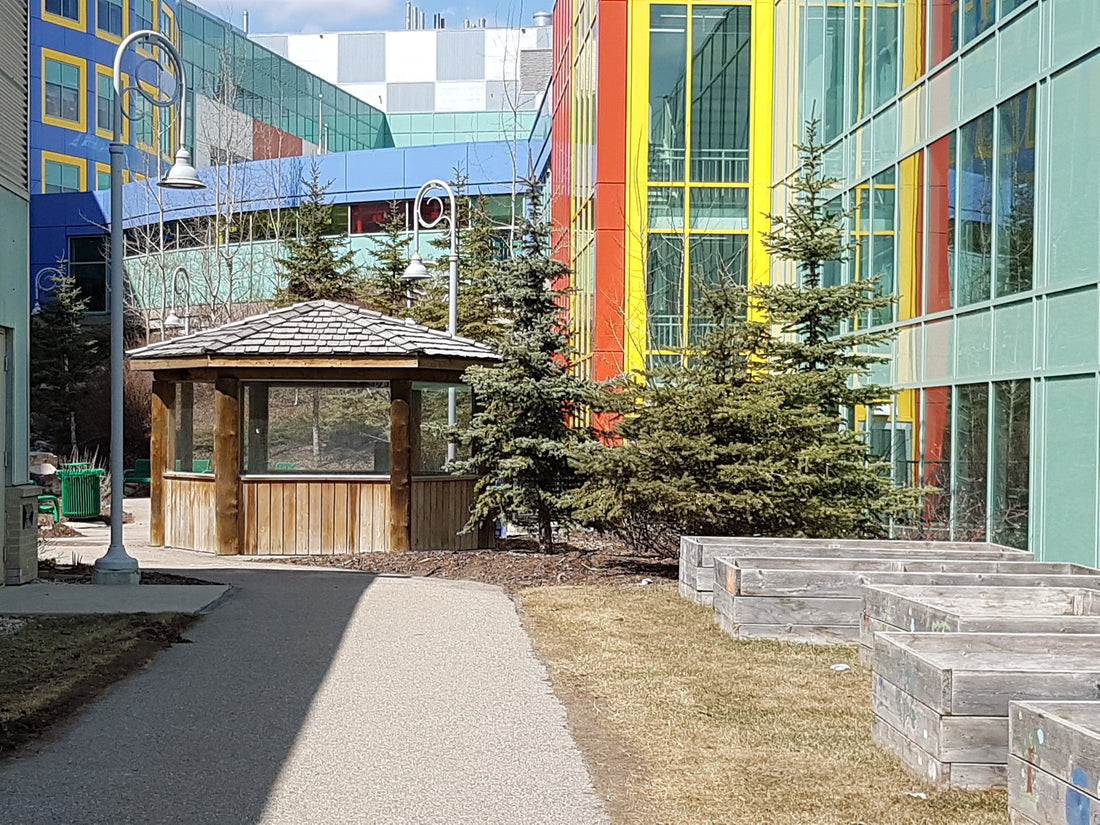Spending time in a hospital isn’t generally a desirable experience for kids or their parents. But when a hospital stay is needed, the horticultural therapy program at Alberta Children’s Hospital is much sought after. Julie Billo, the hospital’s horticultural therapist, says:
If I’m doing my job right, I’m making that generation of kids more aware of how special nature is in their lives. I’m really passionate about it. I feel like I’m planting seeds. I’m teaching them when they’re young, how important nature is to their lives, so it becomes a part of their life.

Julie Billo, Horticultural Therapist at Alberta Children’s Hospital
(Photos by Shelagh Smith except those credited to Julie Billo)
Therapeutic Garden Programs
Ice Cream?!?
Making ice cream is one of Julie’s more surprising horticultural activities. “Why ice cream? They discuss plant origins: Where does sugar come from? How does milk come from plants? Cows and grass, you’re on the right track.” Add in flavourings… Yup, making ice cream can generate a sweet discussion about plant foods. Ditto for these other oft-repeated cooking activities that use garden produce: apple crisp, carrot muffins, chocolate zucchini loaf, salsa and guacamole, and potato salad.


Potatoes harvested from kid’s veggie garden (Photo credit: Julie Billo)
Julie spends about 70% of her time providing therapeutic horticulture programming and the rest of her time maintaining and improving the hospital’s therapeutic gardens. She works three short days per week in the winter months and four to five longer days per week during the growing season.
Most of Julie’s programs are group programs, and most often with a specific patient group. She also does one-to-one sessions when requested.
Drop-in Garden Group
The drop-in group in the art studio is a less structured group, where kids who’ve been in accidents, are sick, or getting therapy may drop in for five minutes or the whole two hours. They cook with fresh ingredients and Julie asks them ‘Where do these foods come from?’ and ‘Have they grown them before?’ She tries to make connections with things they’ve done in the past. Or they might paint a pot and plant a plant.
Julie says, “They don’t know they’re getting therapy” and she calls this “Passive HT” (horticultural therapy).
Eating Disorder Patients Grow Food
The Eating Disorder Clinic provides treatment for girls aged 14 to 24. They have their own garden: The Garden of Wishes. It’s got a new self-watering raised bed which “they’ll be planting with food. They’ll look after and nurture food from seed. It’s not a forced thing; they can join if they choose to, and most of them do because they get to spend time outside in the garden.”
Another activity involves tea roses:
I provide tea roses in several different colours and each colour represents a feeling. I let them pick what they’re drawn to and then we talk about the colour and why they picked it and what it represents. And they’re like ‘oh wow’.
They’re interested because they wonder ‘why did I pick that white rose’ or ‘why did I pick the pink one’. Maybe there’s a memory associated with it or a feeling. We talk about that. I also ask, ‘Have you grown plants before? What kind of plants have you grown? How did you like it?’ We’re connecting what they’re doing with something that made them feel happy in another time.
We also do tropical terrariums made out of mason jars. They learn about the soil layers and they pick a plant. It's something for them to nurture and take care of.
Rotary Flames House Sensory Garden
The Rotary Flames House provides palliative care and respite care. The garden is wheelchair accessible with raised planters. Julie focuses on sensory activities during her monthly sessions with these children. They touch and smell plants and put their hands in the soil. She uses hand-over-hand when necessary to assist kids whose communication and physical abilities require it.


Gordon Townsend School Garden
At the Gordon Townsend School, kids are in rehab from strokes or accidents and they’re working with physiotherapists to improve their mobility. Julie works with these kids in the spring to plant their vegetables and their sensory garden. They’re out of school for four to five weeks in the summer, but they come in and water their garden. “By fall their plants are quite mature and we harvest them and cook things: muffins, salad…”
Mental Health Garden Programs
Julie also works with mental health inpatients who stay for 8 to 12 weeks, as well as mental health day patients. Julie’s passion shines through her words:
I know the kids benefit a lot because the feedback has been phenomenal. Say you’re a mental health patient and you’ve gone through an eight-week program, they always do a debrief as they’re leaving. The staff always want to know what they’re doing that’s good and not good. And HT is one thing that consistently comes up, as the kids absolutely loved it. It obviously benefits, without any research being done, you can obviously see it benefits them. They’re happy.
They come into the group saying ‘This is my favourite group’ or ‘I love coming to this group’. When they say things like that I know that HT has got such a basis in healthcare. Its’s such a no brainer. If you haven’t had it you don’t know what you’re missing. But when you’ve got it… With these fabulous gardens, without a horticultural therapist, would be unfortunate.
Therapeutic Gardens
Alberta Children’s Hospital has several therapeutic gardens.

Year-round Interest From Indoors and Out
Julie was apologetic that I was seeing the gardens in April with piles of snow still around and tulip greens barely emerging. But I was impressed with the bones of the gardens. Trees and shrubs were thoughtfully placed to provide year-round interest and to blend with borrowed views from beyond the hospital grounds.




Just a few weeks later tulips are in full bloom. (Photo credits: Julie Billo)


Several patient groups have their own garden, including a garden that can only be seen when looking out windows from inside the mental health clinic.


Spring view from a clinic window (Photo credit: Julie Billo)
Other gardens and playgrounds are open to everyone.

Despite the late thaw and the cool, windy day:
There are people out here enjoying it. They’re soaking up the sun, they’re looking at the beautiful view. Even though the trees aren’t doing what they normally do [at this time of year], who cares, they’re here. The air, the grass, the smells. People go away feeling better for it. It fills you up.
[You’ll have to take our word for it that there were people enjoying the outdoors. For confidentiality reasons I can’t show any photos of hospital patients and their companions. It was actually challenging to find a moment when the playground was empty so I could take a photo.]
Plenty of critters enliven the hospital gardens: rabbits, a Swainson’s hawk, and swallows that make use of the bird condos.

Friendship Garden
The Friendship Garden has a creek bed with legacy rocks. Each rock has a drawing or message: “A way for patients to leave a piece of themselves behind to help a future patient.”


Apples for Hospital Kids to Pick
The apple orchard has small trees so the kids can pick the apples. “There’s not an apple left at the end of the season.”


Ripe apples in our apple orchard (Photo credit: Julie Billo)
The apple trees are pruned yearly by a dedicated volunteer. Other garden care volunteers come once a week for a couple of hours to work in the specific outdoor areas that Julie looks after.
Corporate groups volunteer their time with projects:
This year we’re taking out all the old planters and putting in new self-watering planters around the hospital. Some raised beds as well. They’re going to help me with taking down the old ones and disposing of them, moving the new ones into place and filling them with soil. Getting them prepped so the kids can plant in them.
Windy Weather
The wind is an ongoing challenge in Calgary’s prairie environment. Julie says, “It blows a gale here. Plant a seed and it gets blown out. The soil is awful. It gets eroded. The good stuff gets blown out and leaves rocks behind. The wind is incredible.” Mulch is applied every couple of years to hold the soil in place.


During cold weather, indoor gardening activities provide a dose of nature. Sensory plants include several varieties of scented geraniums that patients can enjoy and care for.


Passionate About Nature
Julie’s therapeutic garden groups are in high demand. Once the growing season starts and her hours are increased, every hospital clinic wants her to garden with their patients.
People are naturally drawn to nature. Kids are even closer to it than adults. Kids want to roll in the grass, make mud pies, climb trees. Kids want to go in the garden and see what bugs are living there. They’re just so open to it.
I give some kids a bag of seeds to take home with them. ‘I saw something in you; I think you’ve got a real gift for the garden.’ It’s like they’ve already developed a connection and they don’t even know it.
‘You go take this bag of sunflower seeds and you plant them in your garden and watch them grow.’ And they’re thrilled. It’s a bag of seeds but they think it’s Christmas.
Julie laughs. She’s also apt to shed tears about her indispensable role of connecting kids with nature. Her passion shines through her words and her actions as she shows me her life’s work. She says ‘You’ve got to be called to it’ to be a horticultural therapist, so you can share your passion with the next generation of children.

Sunflowers planted by the kids (Photo credit: Julie Billo)

